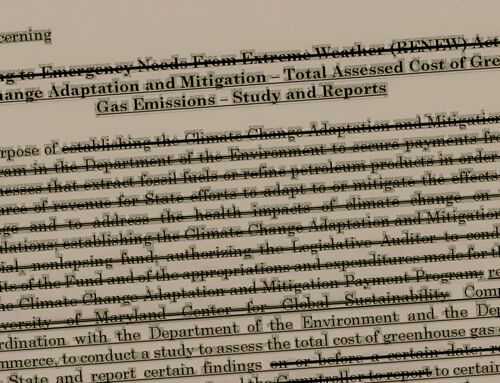View by Topic
Recent Articles
-
Maryland is About to Regulate Mold: But is the Cart Before the Horse?Saturday, May 10th, 2025
-
New Environmental Laws from the 2025 Maryland Legislative SessionSaturday, April 26th, 2025
-
Migratory Bird Treaty Act Does Not Prohibit Incidental Take – AgainSaturday, April 19th, 2025
-
President Trump’s Bold Step to Rein in State Overreach in Climate ChangeSaturday, April 12th, 2025
View by Month/Year
“Green Building Law Update” Headlines
Recent Articles & News from
Stuart Kaplow’s blog
at GreenBuildingLawUpdate.com
- BEPS Redux: The Most Far Reaching Environmental Legislation of the 2025 Maryland General Assembly May 4, 2025
- New Environmental Laws from the 2025 Maryland General Assembly Session April 27, 2025
- Migratory Bird Treaty Act Does Not Prohibit Incidental Take – Again April 20, 2025
- President Trump’s Bold Step to Rein in State Overreach in Climate Change April 13, 2025
Subscribe to the Green Building Law Update!
Stuart Kaplow brings his expertise and extensive experience to the table with his unique digital publication, "Green Building Law Update". Subscribers receive regular updates to keep them informed about important issues surrounding Environmental Law, Green Building & Real Estate Law, as well as the emerging demand for Environmental Social Governance (ESG).
Get fresh content through the lense of Stuart Kaplow's cutting-edge expertise, innovative commentary and insider perspective. Don't miss another issue! Subscribe below.

Green Building may be our Best Hope to Repair the Planet
The de riguer environmental imperative of responding to the immediate threat of global warming through reducing greenhouse gas emissions, to the detriment of other environmental impacts, is simply taking one environmental impact too far.
This is not my perspective alone. Most people identify “clean drinking water” as their top environmental concern. Not surprisingly, in a soon to be published literature search of polls across the globe in the last year, access to “clean potable water” was the top environmental issue. Polling of Americans by Gallup almost always results in a majority expressing “pollution of drinking water” as their top environmental concern, and the same was true this year. Global warming is not at the top of public concern, and what concern there was, has consistently dipped in recent years, despite a vocal coterie of global warming apocalypticism.
I would be remiss if I did not note that this blog post is being written when my office and home both north of Baltimore City are under a boil water advisory not to drink the public water due to contamination with the parasite cryptosporidium, a leading cause of waterborne illness in the United States. Clean drinking water is the principal environmental concern today for those in my office and residents in about half of Baltimore City, Baltimore County, and Howard County who should not drink the water.
However, global warming has sucked the air out of the room, ignoring that it isn’t just about GHG emissions, and definingly leaving no meaningful opportunity for businesses to talk about potable water quantity and quality or humanity’s other environmental impacts, leaving businesses at risk of being single minded to the point of being subject to jeopardy.
There are a variety of ways that companies assess the materiality of environmental matters focused on the “total mix of information from the perspective of a reasonable investor,” the SEC standard (.. which appears to be in conflict with the SEC’s own proposed rule for climate change disclosure above all other environmental matters), and while it is not mandatory for nonpublic corporations it is a good guide to the use of a host of sustainability metrics, from life cycle impact assessment to traditional industrial ecology as well as process design impact assessment for developing increasingly sustainable products, processes, facilities, and companies; which means considering a whole lot more than only climate change including to avoid claims of executional greenwashing.
Those metrics allow the quantification of stressors that have potential environmental effects and that people are apparently concerned about, including:
- acidification
- eutrophication
- ecotoxicity
- fossil fuel depletion effects
- global warming
- ozone depletion
- human health criteria related effects
- human health cancer
- human health noncancer
- tropospheric ozone (smog) formation
- land use, and
- potable water.
That substantive list is substantially the same as the original version of TRACI released by EPA in August 2002.
The TRACI compilation of environmental effects was the basis of the US Green Building Council’s LEED green building rating program. Green building, be it LEED, Green Globes or BREEAM may be the best single activity a business can undertake to repair that breath of environmental effects on the planet. Green buildings reduce negative effects on the natural environment and improve the human condition by using less water, energy, and other natural resources; employing renewable energy sources, eco-friendly and responsibly sourced materials; and reducing emissions and other waste. And having those efforts third party verified limiting possible greenwashing claims and other challenges. I was at Greenbuild 23 last week which heralded the release of LEED v5, so stressors may bend as the public’s interest evolves, but it is still a whole lot more than global warming alone.
In response to including global warming as one of the environmental effects on the list, Christie Todd Whitman, the EPA Administrator in 2002 at the time of the release of the TRACI tool famously told President Bush, “The climate issue is politically challenging not only because it’s at the bottom of people’s priority lists, but also because of overreach on both sides of the debate. Humans aren’t the sole ‘cause’ of climate change, and environmentalists have done a disservice in making that claim too assertively.” She went on to recommend that we must act on climate change with the same fervor that we are acting on the other environmental impacts to protect our planet.
.. which does not sound all that different more than 20 years later, “There’s a lot of climate exaggeration,” said Bill Gates, last month. “The climate is not the end of the planet. So the planet is going to be fine.”
This struck us oddly as the same thing George Carlin said in 1992 when joking about all of the environmental stressors we needed to address, not just climate change, “The planet has been here four and a half billion years. We’ve been here what? 100,000? Maybe 200,000? And we’ve only been engaged in heavy industry for a little over 200 years. 200 years versus four and a half billion. The planet is fine. The people are fucked.”
But the takeaway from all of this is that single shooting climate change is not what the majority of people want and does not satisfy a corporation’s legal requirement to disclose the total mix of information. A holistic response to human beings’ environmental impacts on the health of ecosystems including the health of humans (e.g., why there are more than 100 possible LEED credits) most of which are interconnected, is sustainable and will allow us to repair the planet.









